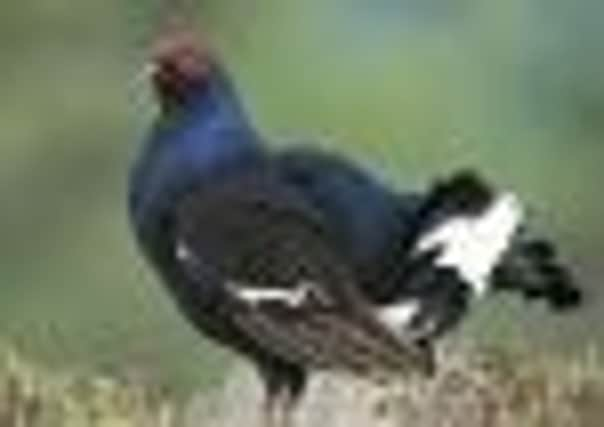Prospects not so black for bird


Every year, Dr Phil Warren hears it with a feeling of apprehension, and throughout the Wimbledon fortnight, he takes more than a casual interest in the weather forecasts.
However, his concern is not about what the skies are likely to look like over south-west London and whether rain might interfere with play.
Advertisement
Hide AdAdvertisement
Hide AdDr Warren wants to know if it’s going to be wet in the farthest corners of the Yorkshire Dales and remoter parts of the North Pennines.
As the Game and Wildlife Conservation Trust scientist leading the project which has saved the black grouse – the most beautiful and fascinating bird of the uplands – from extinction in England, he knows that this is the make-or-break period in their breeding cycle.
There are a couple of small groups in Wensleydale but most of the Dales population is in Swaledale and Arkengarthdale. The highest concentrations are found northwards from County Durham.
“The earliest chicks start to hatch in the week of Royal Ascot”, he says, “but the peak hatching week is the start of Wimbledon.
Advertisement
Hide AdAdvertisement
Hide Ad“It’s a bit of a nervous time, because if you get two or three cold wet days in a row, then we get real problems like we had in 2007 and 2008, which were wash-outs.”
So far this year, Dr Warren is cautiously optimistic. Counts of the birds at the start of the breeding season suggested the species is doing extremely well.
This June it was showery, but not cold, which means that when it rained, the chicks could sit under the mother and when it was dry, the mother could find food without her chicks getting wet and dying of hypothermia.
“If you walk through these grassland moorland-fringe habitats after rain, then you soon get very wet. The actual specific reason why it’s such a problem for chicks we don’t really understand, but what we do know is that unseasonal weather in the latter part of June can be devastating.”
Advertisement
Hide AdAdvertisement
Hide AdIn the mid-19th century, the black grouse was present in every English county. Although the bird is now associated with upland moorland fringes, it used to be present even in Hampshire’s New Forest.
Back then, the English population was measured in tens of thousands, and it was a popular game bird on many shooting estates.
There is a record that in 1870, in a single day, 250 birds were shot at Cannock Chase, in Staffordshire.
A century later, its numbers had dwindled with habitat changes – especially large-scale afforestation after the Second World War – thought to have been a critical factor.
Advertisement
Hide AdAdvertisement
Hide AdHowever, it still had a fairly wide distribution and there were significant populations as far south as Dartmoor and Exmoor, as well as in the Peak District of Derbyshire, the Bowland area of North Lancashire, and the southern fells of the Lake District National Park.
But by the early 1990s, the English population of black grouse had crashed.
The remaining birds were found in four areas – North Yorkshire, Cumbria, Durham and Northumberland.
At that time it was estimated that the annual decline was in the region of 10 per cent, and if no action was taken the bird would eventually become extinct as an English species. In 1996, the Game and Wildlife Conservation Trust set up the North Pennines Black Grouse Recovery Project and this has turned round the birds’ fortunes in England.
Advertisement
Hide AdAdvertisement
Hide AdScotland now has an estimated 65 per cent of the UK population and numbers in Wales have grown to around 240 birds, centred on the Ruabon Mountain and Llandegia area near Wrexham.
In England, black grouse were peaked at 1,200 males in the spring of 2007 but the June downpours which followed, and a wet 2008, wiped out newly-hatched chicks. The exceptional snowfall and frost of winter 2009/10, caused the population in northern England to collapse to an all-time low of 500 males last spring.
This year, the signs are that it will be a good breeding season for black grouse in England. Early morning counts at sites used by the male birds for lekking – the dawn courtship display where they compete for supremacy of their group and the right to mate – are very encouraging.
Last year, a disappointing 500 males were counted at leks in the Yorkshire Dales and North Pennines. This year, it’s 820, despite the fact that in north-west Northumberland, the population is down from 100 males in 2002 to a precarious six this year.
Advertisement
Hide AdAdvertisement
Hide AdA boost for the fragile Yorkshire Dales population has been a successful translocation trial, funded by the SITA Trust, which involved moving males from the core of their range in County Durham, further south to Wensleydale, the fringe of the bird’s English range.
“This has proved to be very successful, albeit for the small number of birds that we could move,” says Dr Warren.
“We’ve established two new leks in Wensleydale and females have been attracted to them, settled there and bred, so that’s a really exciting development.
“We are now seeing males carrying out their unforgettable mating display in areas where they have been absent for 15 years or more.”
There are plans for this work to be expanded. By the time of next year’s Wimbledon, with a bit of help from the weather, there will be more black grouse in the Dales.